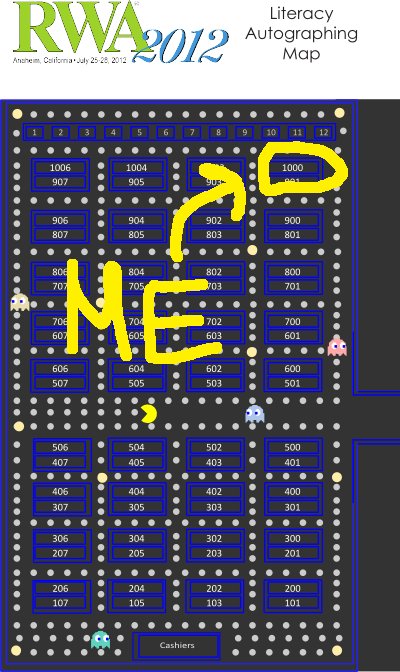Sarah Wendell over at Smart Bitches, Trashy Books, has a post up today about what she calls Unwitting Newsletter Douchebaggery–that is, people signing up other people for newsletters on the basis of the exchange of e-mails, business cards, and loving glances shared across the room. I started to comment over there, but it turned out that what I had to say was only peripherally related to the post, and the content was much more relevant to authors than readers. So I decided to post it here instead.
I think that Unwitting Newsletter Douchebaggery, and its close cousins, Twitter Dumbassery, Goodreads Nitwittishness, and Facebook Spambingo, come to pass because people fall into the error of numerosity. That is, they think that more is better. A mailing list of 10,000 people is better than a mailing list of 1,000. 10,000 Facebook likes is better than 2,000 Facebook likes, and 8,000 Twitter followers is better than 200.
They think this because Successful authors often have large mailing lists, many Facebook likes, and a bunch of twitter followers.
But what they don’t think is this: successful authors have many people on their mailing lists because many people want to buy their books. People actually do like those authors. They want to get their newsletters. The error of numerosity confuses correlation with causation: Successful authors have big numbers as a result of success. If you’ve grown your lists organically, they can help solidify your success. But having big numbers by itself won’t make you successful. It will just make your newsletter more expensive to send.
This is something I learned through experience. I don’t think I’ve ever engaged in Unwitting Newsletter Douchebaggery (I’ve always had a double opt-in for my newsletter, and I’ve always been very clear when someone is doing something that gets them subscribed to my newsletter), but I have engaged in Unwitting Newsletter Ignorance. When I first started out as a baby author, I tried to grow my newsletter mailing list–because bigger numbers are better numbers!–by holding regular contests. And it worked! I got names. One time, my contest got posted on some “win free stuff on the internet” site and my numbers got completely massive that month! Hundreds and hundreds of people signed up in a short space of time. Whee!
So I sent out my newsletter (play obligatory Peter and the Wolf music) and ….
*crickets*
My open stats weren’t great, and there was almost zero effect from sending out a newsletter. Running regular contests took time, energy, and money–the first two of which were in far shorter supply than the last. Eventually, I moved from monthly contests, to quarterly contests, and after two of those, I stopped running contests entirely. Growing my mailing list just did not seem to be worth the time I was spending. I basically neglected my mailing list for a year and a half after that.
But–in retrospect, this is not weird at all–over the course of that year of discontent with my mailing list, my list actually became more effective. The people who didn’t want to buy my books unsubscribed. And the people who were adding themselves–there was still a link on my website; I just wasn’t advertising it–were doing so not in the hopes of some great prize, but because they actually wanted to read my books. My open percentages got bigger; my clickthroughs increased. At this point, now that I can actually see sales in something close to real time, I can send out a newsletter and verify that it is having a real, noticeable effect.*
There’s a reason why people say that the formula for success as an author is “Write a good book. Then write another one.”
It’s not because newsletters, facebook, and twitter can’t help. It’s because focusing effort on growing those things in a nonorganic fashion does very little good. Newsletters and social media aren’t a goal in and of themselves. They solidify success; they cannot create it. No amount of promo-spam will make someone who doesn’t want to buy your book pull out their wallet. But if someone wants to buy your book, you only need to give them a gentle little touch–“Hey, it’s out!” and they’ll squee and rush out, because they’ve been waiting for just that moment.
But it’s not the number of newsletter subscribers, or Twitter followers, or Facebook likers, that makes those things work. It’s the level of interest of the people who subscribe.
So, don’t just avoid being a douchebag. Avoid falling into the pit of numerosity. Having bigger numbers might make you feel better, but if those numbers come from people who don’t want to read your next book, they don’t mean anything.
—–
* At this point, my newsletter is growing at a rate similar to the rate when I held contests, and I can attribute it to one thing: I’ve modified the page that immediately follows the end of a book so that it says something along the lines of, “If you liked this book, sign up to find out when my next one is available.” There’s a clickable link. I don’t offer any reward except finding out about my next book; people who sign up do so because they want to find out about my next book.
Google Analytics tells me that last month, almost 50% of my web traffic originated from people clicking that link.
So I’m not trying to say authors shouldn’t think about growing their newsletter list, or their Facebook fan pages, or any of those other things–not at all. It’s just that every success story I’ve heard about newsletters and Facebook and twitter has involved people saying things like, “I have so much fun with my readers on my Facebook page. We swap recipes!” and never “I had nothing, but then I got 5,000 people to like me on Facebook because I gave away a Kindle Fire, and now I’m selling like mad!”
I don’t think it makes sense to focus on, “How can I make my numbers increase?” It’s much more effective to ask yourself the question: “How can I make it easier for readers who want to read my next book to find out about it?”
Treating my newsletter as a partnership with readers (they want to know about my next book, and I want to tell them) rather than as a promotional activity (I want to show it to as many people as possible, without thinking about their preferences at all) completely changed the effectiveness and reach of my mailing list.
At this point, I would modify the formula above: “Write a good book. Make it easy for the people who like it to find out about the next one. Then write that one.”


